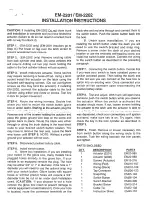
1-51
Where to Put the Restraint (Except Cargo
Vans and Cab and Chassis Models)
Accident statistics show that children are safer if they
are restrained in the rear rather than the front seat.
General Motors, therefore, recommends that child
restraints be secured in a rear seat including an infant
riding in a rear
-
facing infant seat, a child riding in a
forward
-
facing child seat and an older child riding in a
booster seat. If your vehicle has a front passenger air
bag, never put a rear
-
facing child restraint in the front
passenger seat. Here’s why:
CAUTION:
A child in a rear
-
facing child restraint can be
seriously injured or killed if the right front
passenger’s air bag inflates. This is because the
back of the rear
-
facing child restraint would be
very close to the inflating air bag. If your vehicle
has a right front passenger’s air bag, always
secure a rear
-
facing child restraint in a rear seat.
You may secure a forward
-
facing child restraint
in the right front seat, but before you do, always
move the front passenger seat as far back as it
will go. It’s better to secure the child restraint in
a rear seat.
Wherever you install it, be sure to secure the child
restraint properly.
Keep in mind that an unsecured child restraint can move
around in a collision or sudden stop and injure people in
the vehicle. Be sure to properly secure any child
restraint in your vehicle
--
even when no child is in it.
Summary of Contents for 2001 Express Van
Page 1: ......
Page 12: ...x Model Reference This manual covers these models Passenger Van Cargo Van Cab and Chassis ...
Page 127: ...2 50 The Instrument Panel Your Information System ...
Page 307: ...6 38 3 Remove the nuts with a deep socket wrench 4 Remove the hidden upper nuts ...
Page 398: ...7 59 Maintenance Record DATE ODOMETER READING SERVICED BY MAINTENANCE PERFORMED ...
Page 399: ...7 60 Maintenance Record DATE ODOMETER READING SERVICED BY MAINTENANCE PERFORMED ...















































